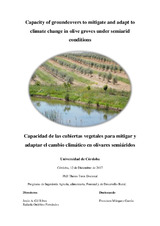Mostrar el registro sencillo del ítem
Capacidad de las cubiertas vegetales para mitigar y adaptar el cambio climático en olivares semiáridos
| dc.contributor.advisor | Gil Ribes, Jesús | |
| dc.contributor.advisor | Ordóñez Fernández, Rafaela | |
| dc.contributor.author | Márquez García, Francisco | |
| dc.date.accessioned | 2018-02-05T08:18:41Z | |
| dc.date.available | 2018-02-05T08:18:41Z | |
| dc.date.issued | 2018 | |
| dc.identifier.uri | http://hdl.handle.net/10396/16070 | |
| dc.description.abstract | El cultivo del olivo representa desde hace más de dos milenios la propia identidad de la cultura mediterránea. Para muchos de los pueblos que se asientan en estas regiones este árbol es su vertebrador social y económico, muy especialmente en la zona sur de España, Andalucía, mayor productor a nivel mundial de aceituna y en donde muchos de sus pueblos el olivar es el único cultivo presente. El olivar juega un papel fundamental en estos ecosistemas semiáridos, ya que contribuye a generar riqueza y recursos en regiones que por norma general presentan unos niveles de desarrollo deficientes. Sin embargo, su cultivo no se encuentra exento de problemas, pues el laboreo continuado, en muchas zonas durante siglos, ha ocasionado el deterioro de la calidad de los suelos, que por norma general presentan concentraciones muy bajas de materia orgánica. Además, si a estos niveles de infertilidad unimos la importante pérdida de suelo que se registra en este cultivo debido a la escasa cobertura del terreno, propiciada por los árboles, y a una orografía abrupta, hacen que el olivar sea especialmente sensible a los efectos adversos del cambio climático, que por otra parte, según demuestran diversos estudios será en las regiones semiáridas mediterráneas donde presente una mayor incidencia nociva a nivel europeo. Desde hace varias décadas se viene trabajando en Andalucía para promover la implantación de cubiertas vegetales en las calles de los olivares, habiéndose ampliamente demostrado como este sistema de manejo de suelo ocasiona que la erosión de los olivares prácticamente desaparezca. Sin embargo, no han sido muchos los trabajos que se han centrado en estudiar las interrelaciones que estas técnicas tienen con la sensibilidad de este cultivo al cambio climático y como su implantación pueda contribuir a adaptar y mitigar sus efectos adversos y menos aún a una escala regional y en un intervalo de tiempo medio-largo. Por tanto, mediante este trabajo se persigue evaluar el efecto que tiene la implantación de diversos tipos de cubiertas vegetales en la capacidad de sumidero de carbono del suelo, en la pérdida de este elemento asociado a los procesos erosivos y finalmente su influencia en el balance de agua del suelo. Siempre comparándolo con el sistema de manejo más común en esta región, el laboreo. | es_ES |
| dc.description.abstract | Olive is a millenary crop in the Mediterranean basin and represents part of its culture. This tree is the social and economic core for most of the villages located in these regions. Especially in Andalusia, South of Spain, the largest world olive producer and where in most of the villages the olive is the only one crop present. Olive plays a key role in these semiarid ecosystems, since it contributes to generate wealth and resources in regions that usually have deficient levels of development. However, its cultivation generates many problems, as the historical continuous soil tillage had produced the deterioration of the quality of the soils, which nowadays present very low concentrations of organic matter. In addition, if at these levels of infertility we join the important soil loss that is registered in this crop due to the scarce coverage of the terrain, favored by the trees, and an abrupt orography, make the olive tree especially sensitive to the adverse effects of the climate change. Which, according to various studies, will be in the Mediterranean semi-arid regions where it has a higher harmful incidence at European level. Since few decades, scientifics and technicians had been promoting the implantation of groundcovers in the rows of the olive orchards. This soil management system has demonstrated to eradicate the erosion in these crops. But, there have not been many studies that have focused on studying the interrelationships of these techniques with the sensitivity of this crop to climate change and how their implementation can contribute to adapt and mitigate their adverse effects, and even less on a regional scale and in a medium-long time interval. Therefore, this work aims to evaluate the effect of the implementation of various types of groundcovers on the soil carbon sink capacity, the loss of this element associated with erosion processes and finally its influence on the balance of soil water. Always comparing it with the most common management system in this region, tillage. | es_ES |
| dc.format.mimetype | application/pdf | es_ES |
| dc.language.iso | spa | es_ES |
| dc.publisher | Universidad de Córdoba, UCOPress | es_ES |
| dc.rights | https://creativecommons.org/licenses/by-nc-nd/4.0/ | es_ES |
| dc.subject | Cambio climático | es_ES |
| dc.subject | Olivar | es_ES |
| dc.subject | Ecosistemas semiáridos | es_ES |
| dc.subject | Laboreo | es_ES |
| dc.subject | Cubiertas vegetales | es_ES |
| dc.subject | Medidas agroambientales | es_ES |
| dc.subject | Agricultura sostenible | es_ES |
| dc.title | Capacidad de las cubiertas vegetales para mitigar y adaptar el cambio climático en olivares semiáridos | es_ES |
| dc.title.alternative | Capacity of groundcovers to mitigate and adapt to climate change in olive groves under semiarid conditions | es_ES |
| dc.type | info:eu-repo/semantics/doctoralThesis | es_ES |
| dc.rights.accessRights | info:eu-repo/semantics/openAccess | es_ES |

